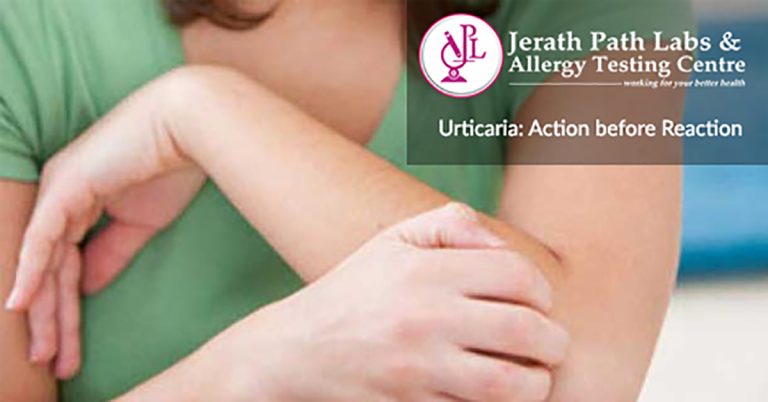Urticaria (hives or nettle rash) is skin’s vascular reaction noticeable by the momentary form of smooth, slightly high papules, or plaques of different dimension, that are erythematous, blanchable on pressure, occur often with painstaking pruritus clinically enduring from few hours to few days, frequently the lesions are self-limiting and resolve without scar but may show return over weeks. Angioedema needs to be notable from urticaria since angioedema is also alike but more severe, can be more severe and fatal. Without systemic response; the growth of urticaria is an isolated occasion. Rarely, it can be a lead up to the development of an anaphylactic response. Acute, chronic, and intermittent are different types of urticaria.
Diagnosis of Urticaria
In people with a history of weals that last less than 24 hours with or without angioedema; urticaria is diagnosed. A family history should be noted. Complete physical examination should be done. Skin prick tests and radioallergosorbent tests or CAP fluoroimmunoassay for specific IgE may be requested if a drug, sustenance a, or inhalant hypersensitivity is suspected in acute urticaria. There are no routine diagnostic tests in chronic unprompted urticaria separately from complete blood count and C-reactive protein, but investigation might be done if a core disorder is assumed.
Autologous Serum Skin Test in Chronic Spontaneous Urticaria
The autologous serum skin test is occasionally carried out in chronic spontaneous urticaria, but its value is uncertain. It is positive if an injection of the patient’s serum under the skin causes a red weal.
Confirmation of Inducible Urticaria
Inducible urticaria is often confirmed by inducing the reaction, for example, scratching the skin in demographist or applying an ice cube in suspected cold urticaria.
Investigations for Systemic Conditions
Investigations for a systemic condition or autoinflammatory disease should be done in urticaria patients with fever, joint or bone pain, and malaise.
Angioedema without Weals
Patients with angioedema having no weals should be asked if they take ACEI drugs and tested for complement C4; C1-INH levels, function and antibodies; and C1q.
Challenges in Urticaria Biopsy
Biopsy of urticaria can be nonspecific and difficult to understand. The pathology depicts edema in the dermis and dilated blood vessels, with changeable mixed inflammatory infiltrate. Vessel wall damage indicates urticarial vasculitis.
Epidemiology of Urticaria:
The worldwide incidence is 0.1%–3% of the population and women are affected two times more likely than men. It is expected that about 1 in 5 people will have urticaria once in their lifetime and this is prevalent across all age groups. Up to 1% of the populations suffer from the disease of chronic urticaria (CU) and all age groups seem to be affected, although the crest incidence lies between 20 and 40 years of age. In most of the cases, the disease lasts between 1 or 5 years, but the duration can vary for the patients with severe urticaria, those with concurrent angioedema, those with the physical component, and those with a positive autologous serum skin test.
Unraveling Autoantibodies and Cutaneous Activation
In spite of the fact that up to half of the patients with CIU have an IgG autoantibody coordinated against the alpha subunit of the high-affinity IgE receptor (FcεR1α) which is accepted to be the pathophysiological premise of immune system urticaria, the role of antithyroid antibodies on persistent cutaneous mast cell and basophil initiation remains doubtful.
Exploring the Coagulation Cascade’s Intriguing Connection
The role of the coagulation cascade, particularly the extrinsic pathway, is fascinating as patients having severe disease have an elevated thrombin generation. Higher fragment F(1+2), D-dimer, and activated factor VII plasma levels are observed, along with rising tissue factor reactivity in the skin.
Unveiling Hypercoagulability in Chronic Urticaria
The levels of fibrinogen, D-dimer, fibrin, and fibrinogen degradation products were significantly raised in CU patients with a hypercoagulable state on APTT waveform analyses, as shown by Taked and colleagues.
Acute Phase Reactants and Cytokines in Severe CU
It is, therefore, not astonishing that acute phase reactants like C-Reactive Protein (CRP) and procalcitonin levels are high in patients with severe CU in comparison to healthy controls or mild CU patients. This includes several other cytokines and the soluble serum factor leading to the release of histamine from basophils.
Beyond Histamine: The Complex Interplay of Mediators
Even though histamine plays an important role in diseases like CU and eczema, prostaglandins, leukotrienes (LTs), and cytokines such as IL-31 seem to extend the inflammatory process.
Treatment for Urticaria
The consensus guidelines have adopt the management of urticaria into
(1) pharmacotherapy nonspecific and specific
(2) avoidance measures.
The first approach is reducing or inhibiting mast cell mediator release and the most regularly used drugs (nonspecific approach) that inhibit mast cell release are corticosteroids. To treat urticaria, continuous or prolonged use of corticosteroids is not suggested as the risks and long-term side effects prevail over the benefits. Specific treatment approaches involve the use of non sedating long-acting antihistamine (anti-H1) drugs such as cetirizine, levocetirizine, and fexofenadine that provide both anti-allergic and anti-inflammatory effects, such as inhibition of cytokines release from basophiles and mast cells as well as decline of chemotactic activity of eosinophils. Doxepin, a tricyclic antidepressant, is the only agent that blocks both H1- and H2-receptors, and can be helpful in the selected patients who experience important psychosomatic symptoms of despair and fretfulness due to the urticaria.
The second approach i.e. avoidance approach outlines eradication or treatment of eliciting stimulus or reason (such as nonsteroidal anti-inflammatory drug-induced urticaria/angioedema, physical causes, management of an infectious trigger, etc.) that is not probable in all cases (i.e., those with CIU) . In line with this “infectious trigger,” the approach that is gaining relevance is the consideration of Helicobacter pylori induced gastritis and urticaria, and some reports of long-lasting remission of urticaria can be seen in patients following eradication therapy.
Discover the source of your discomfort – contact Jerath Path Labs for precise urticaria testing.

